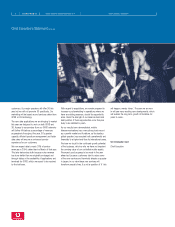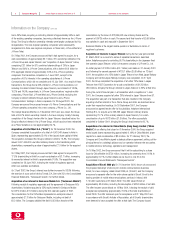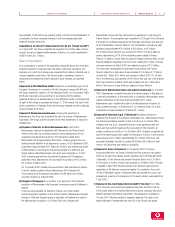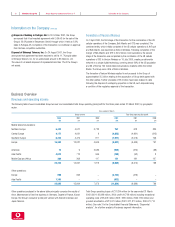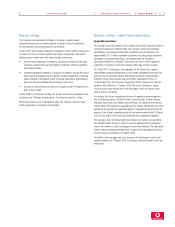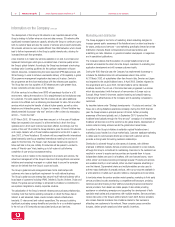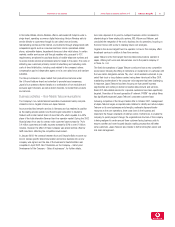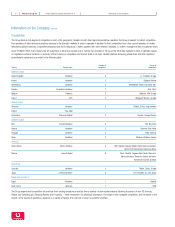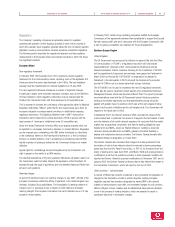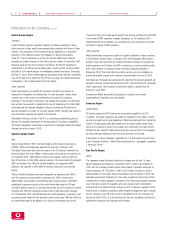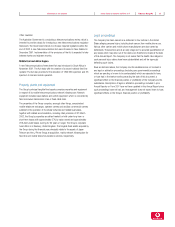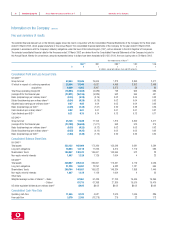Vodafone 2002 Annual Report Download - page 18
Download and view the complete annual report
Please find page 18 of the 2002 Vodafone annual report below. You can navigate through the pages in the report by either clicking on the pages listed below, or by using the keyword search tool below to find specific information within the annual report.
Vodafone Group Plc Annual Report & Accounts and Form 20-F Information on the Company16
Vodafone is the second largest operator in Portugal in terms of total customers,
but has maintained its market leadership in the corporate sector with more
contract customers than any of its competitors. During the 2002 financial year,
Vodafone Portugal increased its registered customer base by 15% to 2,838,000
at 31 March 2002.
Vodafone Portugal was awarded one of four 3G licences in January 2001 for a
fee of approximately £65 million.
Spain
Through a number of agreements entered into during January, July and
September 2000, and following the receipt of regulatory approvals, the Group
increased its shareholding in Airtel from 21.7% to 73.8% on 29 December
2000. Airtel, which now operates as Vodafone in Spain, has been consolidated
in the Group accounts as a subsidiary undertaking from that date. On 29 June
2001, the Group completed its acquisition of a further 17.8% stake in Airtel for
a cash consideration of 11.77 billion (approximately £1.1 billion), which has
increased the Company’s ownership interest to approximately 91.6%. On 2 April
2002, the Group announced that it had acquired a further 2.2% stake following
the exercise of a put option held by Torreal S.A., which increased the
Company’s equity interest in Airtel to 93.8%. The remaining shareholder retains
a put option to sell its stake in Airtel to the Company. See note 28 to the
Consolidated Financial Statements, “Capital Commitments”, for further details.
Vodafone Spain’s network consists of 66 MSCs and 6,603 base stations, giving
population coverage of 98%. Vodafone Spain had 7,905,000 registered
customers at 31 March 2002, representing growth of 11% in the year, with 55%
of the customer base connected to its prepaid tariffs. As at 31 March 2002,
active customers represented 89% of the total registered customer base.
In March 2000, Airtel was awarded one of four 3G licences by the Spanish
government, and plans to open its 3G network for services later in 2002.
Americas
The Group’s interests in the Americas comprise a 45% ownership interest in
Verizon Wireless, which was formed at the beginning of the 2001 financial year
by the combination of the US cellular operations of Vodafone, Bell Atlantic and
GTE, a 34.5% interest in Grupo Iusacell and the Group’s Globalstar service
provider operations.
United States
The Group owns 45% of Verizon Wireless and designates three of the seven
members of Verizon Wireless’ board, while Verizon Communications designates
the four other members. Verizon Wireless has filed a Registration Statement
with the SEC relating to a proposed initial public offering of a minority stake in
the partnership.
The mobile telecommunications market in the United States currently consists of
six nationwide competitors and a number of regional and smaller rural carriers.
Verizon Wireless is the leading mobile telecommunications provider in the United
States in terms of number of customers, network coverage, revenues and cash
flow. The approval of the formation of Verizon Wireless by the US Department of
Justice was subject to a consent decree that called for the disposition of one of
two competing mobile properties in each market where an overlap would be
created by the new venture. It is estimated that the overlapping operations
served approximately 3 million customers in several major US markets. Disposals
of overlapping properties generated proceeds of approximately £1.8 billion to the
Group in the 2001 financial year and £151 million in the 2002 financial year.
Due to the economic slowdown in the US, net customer growth has slowed
considerably from prior years. However, Verizon Wireless increased its customer
base by 9% over the 2002 financial year and ended the year with a registered
customer base of 29,585,000, of which 94% were on contract plans.
Verizon Wireless was the first major US carrier to launch CDMA2000 1XRTT
technology in major metropolitan markets which, including additional markets
activated in April and May 2002, brings total coverage to 130 million people –
60% of the Verizon Wireless national footprint. The service, branded Verizon
Wireless Express Network, increases the capacity of the network without the
need for additional spectrum and also offers higher data rates.
Verizon Wireless offers analogue and digital service in all of its US markets, its
digital service being principally based on CDMA technology. Since the US
operations offer dual-mode cellular telephones capable of sending and receiving
both analogue and certain digital transmissions, Verizon Wireless’ analogue and
digital cellular customers can roam to virtually any cellular market in the United
States. Substantially all of the company’s network capital expenditures relate to
the expansion of digital capacity and coverage, although it is expected that
analogue and digital technologies will continue to co-exist for the foreseeable
future, due to the existing base of analogue customers and the fact that
analogue networks provide the only common roaming platform currently available
throughout the US.
During the year ended 31 March 2002, Verizon Wireless continued to focus on
gaining and retaining high value customers through new customer additions,
the migration of existing analogue customers to digital price plans and churn
management programmes. At 31 March 2002, digital customers totalled
approximately 80% of the customer base.
Verizon Wireless is currently conducting trials of its next generation services
which are expected to enhance the service to the customer, granting more
secure and faster mobile access to corporate intranets. Next generation services
are also expected to provide business customers with the functionality to use the
Verizon Wireless network as an extension of their corporate Local Area Network
or intranet, allowing them to effectively work from any location. The services will
also allow for a range of multimedia services to be offered, including services
such as video and audio streaming and interactive gaming.
In January 2001, Verizon Wireless was declared the winning bidder for 113
licences in the Federal Communications Commission’s (“FCCs”) auction of
1.9 GHz spectrum, which would add capacity for advanced services in markets
including New York, Boston, Los Angeles, Philadelphia, Washington, D.C., Seattle
and San Francisco. While 33 of the licences were awarded to Verizon Wireless
and transferred to the company for approximately $82 million, 67 of the
remaining 80 licences are subject to litigation following the successful appeal to
the federal courts by NextWave Personal Communications Inc. (“NextWave”),
the entity that originally held most of the re-auctioned 1.9 GHz spectrum.
The licences, which would be suitable for the provision of 3G services, were
initially awarded to NextWave, an operator which has subsequently sought
Chapter 11 bankruptcy protection. The Court of Appeals for the District of
Information on the Company continued


